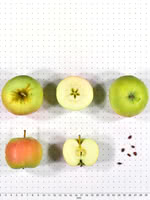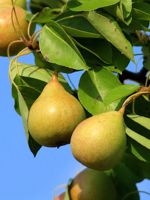Mon-Fri 9am - 5pm Mountain time
Antonovka Apple vs Loving Pear
Malus pumila var. Antonovka (Malus domestica)
Pyrus Loving
NOT AVAILABLE THIS SEASON - MIGHT RETURN
COMING SOON
(new stock expected: later this season)
Originally created in Russia, this apple tree is incredibly cold hardy and commonly used as a root stock for other apple breeds.
Cross pollination is required with another apple or crabapple tree in order for fruit to be produced. Generally, fruit production does not occur until the tree has reached 5-7 years of age.
Its fruit are yellow/green, low sugar, late fruiting and great for pies and cider.
Note: Unfortunately this difficult to grow species is not currently scheduled to grow at TreeTime.ca. Perhaps try purchasing seed from SeedTime.ca and growing your own? Or sign up for a restock notification above.
Loving Pear is a Russian pear variety with a mild sweet flavor and a hint of sour. It is known for being cold hardy and disease resistant. They are green in colour but will transition to have a slightly golden red blush when ripe. With a minimal neck, they have a more rounded appearance.
They ripen in early September. It is recommended that they are harvested as the seeds begin to brown. They can finish ripening after picking. They keep well in cold storage and are suited for fresh eating, juicing, and dehydrating.
The Loving Pear requires a second variety for cross pollination. Some compatible varieties include Krazulya, Golden Spice, and others.

